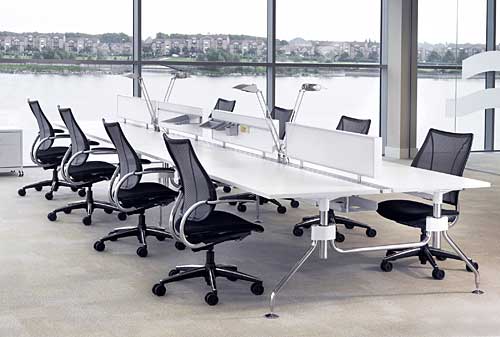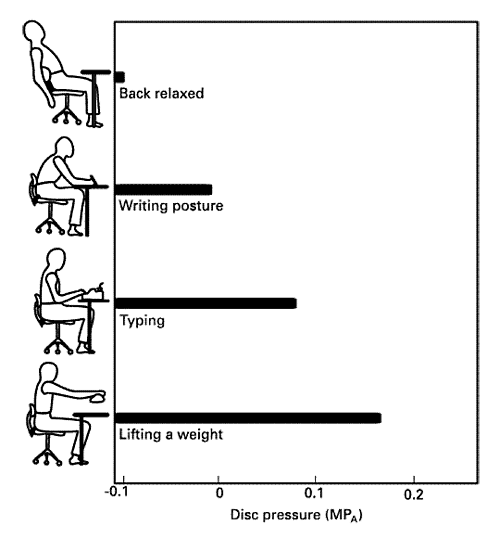Choosing an Office Chair: An Informed Decision for Comfort and Health
Physiology and Biomechanics of Sitting
Back pain is the single most expensive health problem for working age adults and the most challenging ailment for the medical profession. Partly because so many physical, social and psychological variables are involved, only half of lower back pain cases have identified causes. Since the use of ergonomic seating can help address at least one of these variables, it behooves designers and facility managers to become familiar with the physiology and biomechanics of seating.
|
The inward curve formed at the cervical region of the spine is referred to as a lordotic curvature. In the mid-back area, twelve thoracic vertebrae at the lower end of the spine curve away from the body to form a kyphotic curvature. Like the neck, the five lumbar vertebrae also form an inward, lordotic curvature. Vertebrae stack on top of each other centrally and at two lateral buttresses called facet joints. A primary goal of well-designed task chairs is to promote the spine's natural curvature.
Intervertebral discs, made up of fibrous cartilage, serve to separate the vertebrae and give them flexibility and cushioning. Through aging, inadequate nutrition and continued postural and activity stressors, the disc cores lose their strength and flatten. This brings the vertebrae closer together causing wear and tear on the facets and possible pain if impingement on a neighboring nerve occurs. When a person is seated, the lumbar region of the lower back changes back and forth from a lordotic to a kyphotic curve depending on the tilt of the pelvis, which in turn affects the discs.
When the seated body is upright, thick layers of muscles surrounding the bony core of the spine contract to support it. If the person bends forward, the back muscles lengthen to keep the person from slumping over the desk, while the abdominal muscles shorten and contract. If the person is leaning forward for an extended period of time, muscles become fatigued. Plus, if the neck moves forward, the muscles at the back of the neck need to work extra hard to maintain that posture. One researcher measured the disc forces of a person seated in a task chair at a workstation and found that the upright seated posture while using a keyboard produced higher forces than all other postures and activities other than lifting a weight while seated.
Pain and injuries can occur when the body is not stabilized or supported and muscles become fatigued as they work at maintaining posture. They can also occur if a posture is retained for a length of time without movement. "Any fixed posture, no matter how closely it approaches the optimal, will generate muscle fatigue," says Marvin Dainoff, Ph.D., Director of the Ergonomic Research Center at Miami University of Ohio. "Therefore, it is important to build in flexibility to allow operators to shift positions easily." Movement provides nourishment for the spine, keeps the joints lubricated and flexible, improves circulation and removes waste products from the muscles.
|











